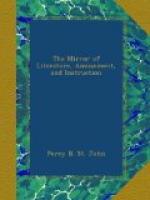Benevolence—In Henri Quatre, where it is large. In Bellingham, Griffiths, and the Charibs, very small. In King Robert Bruce, moderate.
Veneration—An individual may have this organ very large, without possessing a high degree of religious feeling. Voltaire, in whom the organ was extraordinarily large, affords a striking example of this. He embraced every opportunity of turning religion into ridicule; but still, in him, we find the strong manifestation of the faculty, in the high and almost servile degree of deference which he paid to superiors in rank and authority. In Raphael, Bruce, and the Negroes, this organ is large. In Dr. Hette, small.
Firmness—In King Robert Bruce and the American Indians, large.
Hope—In Raphael, large; in Dr. Hette, small.
Ideality—In Milton, Shakspeare, Raphael, Wordsworth, Haydon, and Byron, large. In Mr. Hume and Bellingham, small.
Wit—According to Dr. Spurzheim, the formation of this faculty is to give rise to the feeling of the ludicrous, creating, when strong, an almost irresistible disposition to view every object in that light, while Dr. Gall defines it to be the predominant intellectual feature in Rabelais, Cervantes, Boileau, Swift, Sterne, and Voltaire. In Sterne, Voltaire, and Henri Quatre, this organ is large. In Sir J.E. Smith, Mr. Hume, and the Hindoos, small.
Imitation—In Raphael, Clara Fisher, and uniformly in those artists and players who have distinguished themselves for their imitative powers, large.
Individuality—In the French, generally large; moderate in the English, and in the Scotch, small.
Form—To judge of form in general. The function of this faculty is essential to those engaged in the imitative arts: it enables the painter to distinguish the different casts of features and countenances in general; and upon the same principle, is of the most essential service to the mineralogist. The organ is found large in King George III., and in the Chinese sculls.
Weight or resistance, essential to a genius for mechanics, enabling the individual to judge of momentum and resistance in that branch of science. The organ is large in Brunel and Sir Isaac Newton.
Colouring—remarkably developed in the portraits of Reubens, Rembrandt, Titian, Salvator Rosa, and Claude Lorraine, where its large size is indicated by the arched appearance of the eyebrow in its situation; and in the masks of the late Sir Henry Raeburn, Wilkie, and Haydon, by the projection forwards of the eyebrow at that part.
Locality—or the power of remembering localities, in Kepler, Galileo, Newton, Tycho, Descartes, Sir Walter Scott, and Captain Cook, is large.
Number, or a talent for calculation—in the portraits of Euler, Kepler, Laplace, Gassendi, &c., and in George Bidder, Humboldt, and Colburn, large.
Tune—In Gluck, where it has a pyramidal form. In Mozart, Viotti, Turnsteg, Dussek, and Crescenti, where it is distinguished by a fullness and roundness of the lateral parts of the forehead.




